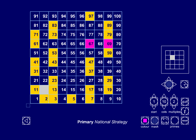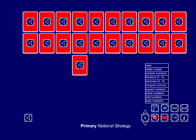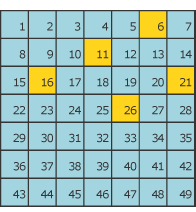Consolidation and practice
These resources are to support children in guided or independent work. Roll over the highlighted resources for a description.
Number grid

This interactive teaching program (ITP) is an ICT-based tool to support the exploration of number, reasoning and problem solving. Number grid ITP allows the child or teacher to generate a number grid with different starting numbers, orientations and numbers of columns. Individual numbers or chosen multiples can be coloured and numbers masked to explore number sequences and patterns and develop children's ability to predict and generalise.
Twenty cards

This interactive teaching program (ITP) is an ICT-based tool to support the exploration of number, reasoning and problem solving. Twenty cards ITP allows the child or teacher to create a sequence or random set of numbered cards. The stacks created can support work on identifying, describing, extending and generating sequences.
Opportunities to use and apply
Possible contexts include:
- Investigating patterns and spatial representations of known sequences of numbers, e.g. multiples, square numbers and triangular numbers.
- Sequences related to properties of shape, e.g. find the total of the internal angles in a triangle, a quadrilateral, a pentagon, etc.
- Sequences produced from continuing patterns, e.g.

Confirming learning
Ask probing questions such as:
- A sequence starts with 1 and has the rule 'add 6'. Work out what the 5th term will be. Amy thinks that the sequence will contain the number 100. Is she correct? Explain how you know.
- Josh continues this pattern. He counts the squares in each shape and writes this down as a sequence. He says, 'No matter how far you go, there will never be a multiple of 4 in the sequence'. Is he right? How do you know?

- Sequence A: 3, 6, 9, 12... Sequence B: 5, 10, 15, 20... Sequence C consists of the terms that appear in both sequence A and sequence B. Give a three-digit number that will be in Sequence C and explain how you know. Can you give another?
 , 7, 10, 13, 16,
, 7, 10, 13, 16,  ,
, 
 ,
, 
 , 4, 8, 16, 32,
, 4, 8, 16, 32,  ,
, 
 ,
,  , 21, 13, 5
, 21, 13, 5 , 1,
, 1,  , 9
, 9
 Counting and understanding number and associated objectives
Counting and understanding number and associated objectives



